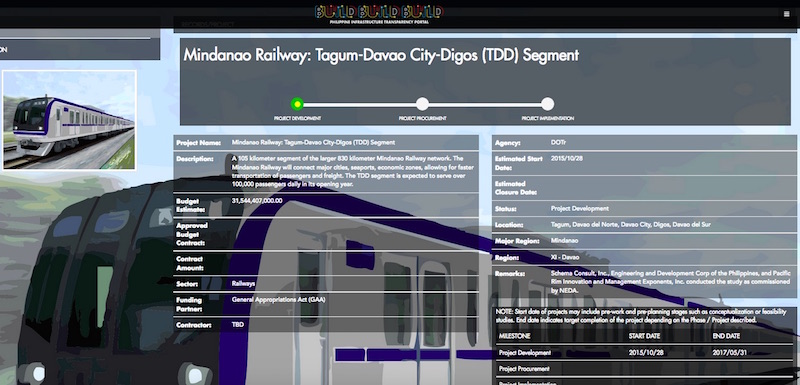DAVAO CITY (MindaNews/16 January) – The government will build a single-track diesel-run railway instead of a modern dual-track electricity-powered one for the first 102-kilometer portion of the Mindanao Railway Project, Mindanao Development Authority (MinDA) Assistant Secretary Romeo Montenegro said.
The segment, to be funded mainly by China, spans the cities of Tagum, Davao and Digos.
Montenegro told reporters Wednesday that the P81.9-billion railway project was among the major infrastructure projects that were up for implementation after the National Economic Development Authority (NEDA)-Board confirmed in December 2019 the earlier approval made by the Investment Coordination Committee-Cabinet Committee (ICC-CabCom).
NEDA Board-approved projects were presented in a meeting held in Manila last month, according to Montenegro.
 The Mindanao Railway project begins with the first segment, TDD for Tagum City in Davao del Norte, Davao City and Digos in Davao del Sur. Courtesy of www.build.gov.ph
The Mindanao Railway project begins with the first segment, TDD for Tagum City in Davao del Norte, Davao City and Digos in Davao del Sur. Courtesy of www.build.gov.ph
“In that presentation, it was already cited the first phase of the Mindanao Railway particularly the TDD line is going to be a one-track locomotive. I’m not sure which in the entire process was it changed to that design from the proposed two-track electrified but in the last presentation of listed projects that was what we saw particularly in terms of the final design,” he said.
In a phone interview on Thursday, Transportation Assistant Secretary Eymard Eje clarified that what the ICC-CabCom had approved in July 2019 was the proposal for a single-track diesel-operated railway, and not the dual-track electricity-powered technology.
Eje said Transportation Secretary Arthur Tugade wanted to put up a dual-track electricity-operated train for Mindanao but NEDA-ICC chose the original proposal for a single-track diesel-run model.
Asked on what basis the reversion was made, Eje said: “I am not in the position to answer that.”
Montenegro explained the NEDA-ICC considered the “viability” of having to pursue a “two-track electric design versus a one-track locomotive” type, which had gone through a thorough evaluation and review by a technical team of the agency.
“It was very different from what MinDA had been espousing especially if you recall during the time of late secretary Datu Abul Khayr Alonto up until his death, he really envisioned for a legacy railway of the President in Mindanao which is high speed and two-track electrified design,” Montenegro said.
He said several Mindanawon leaders wanted a two-track electricity-run railway project.
“We are awaiting the progress of that because there are many other Mindanao leaders [who] upon learning that the design approved was a one-track locomotive, also exerted efforts towards conveying to the national government that it be reverted to two-track electric design,” he said.
For his part, Antonio S. Peralta, executive director of the European Chamber of Commerce of the Philippines-Southern Mindanao Business Council, said the decision to change the project design might be due “to the economics of implementing this,” considering that the budget had been increased from P35.9 billion to P81.9 billion.
“It’s all about affordability on the matter of the change in the railroad design. This is a hefty increase from the original budget. Projects of these scale require a thorough due diligence process,” he said.
In a press release on July 15, 2019, the ICC-CabCom approved the increase last year to cover the changes in the cost of structural and construction works, among others. In terms of scope, the committee also approved the additional Davao Satellite Depot of the MRP-TDD.
Target groundbreaking in Q1 2020
Eje said DOTr eyes to hold the groundbreaking of the TDD segment or the phase 1 in the first quarter of this year.
Phase 1 will have eight stations, namely: Tagum; Carmen; Panabo; Mudiang in Bunawan, Davao City; Davao Terminal; Toril; Sta. Cruz; and Digos.
The 1,550-kilometer Mindanao Railway Project aims to connect key cities of Davao, Butuan, Surigao, Cagayan de Oro, Iligan, Cotabato, Zamboanga and General Santos upon its completion.
But Montenegro said the DOTr timeline was unrealistic.
“Definitely if you look at it in reality, that particular timeline is not possible given the current situation. Nothing is concretely moving yet. The bidding itself will take months if not years depending on how it will proceed and whether or not it will not run into trouble with all other issues,” he said.
Unless actual constructions have started already, Montenegro believed there are still chances the project can be changed to a modern dual-track electricity-powered railway instead of what had been approved.
“There is still opportunity to expect change on that and then there is still opportunity to get that decision from the national government through NEDA,” he said.
85% from Chinese funds
According to Eje, the resources needed to build the railway comprised 15% from the General Appropriations Act and 85% of the Official Development Assistance from China.
The agency, however, is awaiting the submission of the separate shortlists from the Chinese government for the selection of a project management consultant and design and build contractor from the Chinese Embassy in Manila.
He said the consultant would monitor the work of the contractor, which will make the structural design plan of the railway and submit it to the Project Management Office of the Department of Transportation (DOTr) for approval.
The official believed the target groundbreaking this quarter is feasible, provided the embassy is able to submit the shortlists sooner.
“Kung kami ang masusunod (if we can have it our way), we want the project to immediately start… Other matters are not within our hands like the NEDA approval last December and also the submission of shortlists from the Chinese government is incumbent upon the Chinese government,” he said.
Eje said the selection of consultant and contractor goes through a process, and civil works can proceed after the groundbreaking.
After the selection the DOTr will bid out the project, he said.
He assured Mindanawons that the agency was doing all it can to get the project started immediately and completed before the end of the term of President Rodrigo R. Duterte in 2022.
He said the agency is working double-time to complete the acquisition of the road right of way.
At present, he said, there is “evaluation and validation” for the properties located along the railway path to make sure the right owners and not just any other claimants get compensated.
“Once the appraisers complete the validation, the processing of the payment will immediately proceed. If you will remember, during the survey, malapad yung sinusurvey namin (the area surveyed was so wide), but it does not necessarily mean yung buong yung dadaanan, kasi may adjustments kung saan matatamaan (all of it will be covered since adjustments were made),” he said.
The DOTr targeted to see the partial operation of the TDD segment by end-2021 and full operation before Duterte’s term ends, Eje said.
According to DOTr, the railway’s first segment will reduce travel time from Tagum City, Davao del Norte to Digos City, Davao del Sur from 3.5 hours to 1.3 hours once it starts operating in 2022.
It added the rail line will be built with a single track, with provisions for future tracks and electrification. It will have six five-car passenger trains with three spare cars, four locomotives and 15 freight cars.
Upon project completion, the DOTr expects the daily ridership of the Tagum-Davao-Digos segment to increase to 134,060 by 2022.
The DOTr projects the daily ridership to further increase to 237,023 by 2032 and 375,134 by 2042. (Antonio L. Colina IV/MindaNews)
